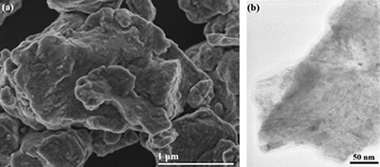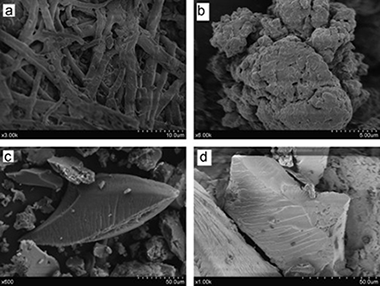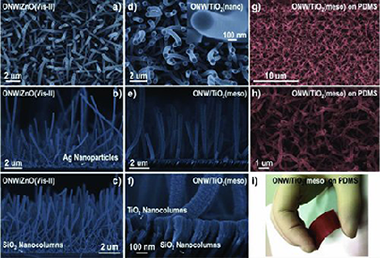Artículos SCI
2013
2013
Fotocatálisis Heterogénea: Aplicaciones
Preparation of Titanium Oxide/Silicon Oxide (TiO2/SiO2) systems through the solvothermal method for applications in photocatalysis
Galeano, L.; Navío, J.A.; Restrepo, G.M.; Marín, J.M.Información Tecnológica, 24 (2013) 81-92
Show abstract ▽

Sistemas Óxido de Titanio/Óxido de Silicio (TiO2/SiO2) fueron obtenidos por anclaje de TiO2 en SiO2. El fotocatalizador TiO2 se obtuvo por alcohólisis del TiCl4 con 2-propanol y posterior cristalización a presión autógena a 200 °C, excluyendo etapas de calcinación a altas temperaturas. Se emplearon diferentes relaciones SiO2/TiCl4 para determinar su influencia en la estabilidad, propiedades y fotoactividad de los sistemas TiO2/SiO2. La actividad fotocatalítica fue evaluada por la fotodegradación de metanol en fase gaseosa. El TiO2 cristalizó como fase anatasa o como una mezcla rutilo/anatasa, dependiendo por la relación SiO2/TiCl4 inicial. Los resultados muestran que se producen materiales compuestos con alta cristalinidad del TiO2. Se encontró también que hay una fuerte relación entre la actividad fotocatalítica con las propiedades fisicoquímicas y de estas con las composiciones iniciales de síntesis.
Diciembre, 2013 | DOI: 10.4067/S0718-07642013000500010
Reactividad de Sólidos
Mechanochemical synthesis of ZrB2–SiC–ZrC nanocomposite powder by metallothermic reduction of zircon
Jalaly, M; Tamizifar, M; Bafghi, MS; Gotor, FJJournal of Alloys and Compounds, 581 (2013) 782-787
Show abstract ▽

Aluminium and magnesium were used in the M/ZrSiO4/B2O3/C (M = Al, Mg) system to induce a mechanically induced self-sustaining reaction (MSR). Aluminium was not able to reduce the system to the desired products, and the system became amorphous after 10 h milling. However, nanocomposite powder of ZrB2–SiC–ZrC was in situ synthesized by the magnesiothermic reduction with an ignition time of approximately 6 min. The mechanism for the formation of the product in this system was determined by studying the relevant sub-reactions.
Diciembre, 2013 | DOI: 10.1016/j.jallcom.2013.07.142
Reactividad de Sólidos
Bio-inspired mechanochemical synthesis of semiconductor nanomaterial using eggshell membrane
Balaz, M; Balaz, P; Sayagues, MJ; Zorkovska, AMaterials Science in Semiconductor Processing, 16 (2013) 1899-1903
Show abstract ▽

Eggshell membrane and lead acetate were successfully used as precursors for the mechanochemical synthesis of lead sulphide nanocrystals with crystallite sizes ∼8 nm. XRD, specific surface area measurements, SEM and EDX were used to characterise the synthesised material. The mechanochemical synthesis follows three-step mechanism. The “fish-like” grains with sizes around 30 μm were obtained.
Diciembre, 2013 | DOI: 10.1016/j.mssp.2013.06.024
Nanotecnología en Superficies y Plasma
Vertically Aligned Hybrid Core/Shell Semiconductor Nanowires for Photonics Applications
Macias-Montero, M; Filippin, AN; Saghi, Z; Aparicio, FJ; Barranco, A; Espinos, JP; Frutos, F; Gonzalez-Elipe, AR; Borras, AAdvanced Functional Materiales, 23 (2013) 5981-5989
Show abstract ▽

A family of 1D organic/inorganic core/shell materials formed by an inner organic nanowire (ONW) conformally covered with an inorganic wide band gap semiconductor (ZnO or TiO2) layer is presented. The developed procedure is a two-steps vacuum methodology involving the formation of supported single crystal small-molecule nanowires by physical vapor deposition and plasma enhance chemical vapor deposition (PECVD) of the inorganic shell. Critical characteristics of the last technique are the possibilities of low temperature and remote configuration deposition. Additionally, an initial step has to be included in order to create nucleation centers for the growth of the ONWs. The procedure and its general character in terms of the variability in organic core and inorganic shells composition and the applicability of the technique to different substrates are presented. The formation of the inorganic shell with no damage of the organic core single-crystalline structure is demonstrated by high resolution transmission electron microscopy. The vertical alignment of the hybrid nanostructure is achieved thanks to the interaction of the 1D organic nanostructured surfaces and the glow discharge during the deposition of the inorganic shell by PECVD. The optical properties of these core/shell NWs are studied by fluorescence spectroscopy and microscopy, and their application as nanoscale waveguides in the 550–750 nm range addressed.
Diciembre, 2013 | DOI: 10.1002/adfm.201301120
Materiales de Diseño para la Energía y Medioambiente
Modeling Macro-Sized, High Aspect Ratio Through-Hole Filling by Multi-Component Additive-Assisted Copper Electrodeposition
Childers, AS; Johnson, MT; Ramirez-Rico, J; Faber, KTJournal of the Electrochemical Society, 160 (2013) D3093-D3102
Show abstract ▽
A multi-element, time-dependent model is used to examine additive-assisted copper electroplating in macro-channels. This model is an adaptation of the work of Akolkar and Landau [J. Electrochem. Soc., 156, D351 (2009)], used to describe plating in micro-vias for integrated circuits. Using their method for describing species movement in the channel, the model has been expanded to include transport and adsorption limitations of the inhibitor and accelerator, as well as the copper ions in solution. The model is used to investigate copper plating as an infiltration method across many size scales and aspect ratios. Biomorphic graphite scaffolds produced from wood are used as a representative system and the results of a two-additive bath are used to characterize the behavior of the additives and determine the effectiveness of the plating. The results indicate that at macro-scales, channel dimensions play an increasingly important role in dictating the behavior of additive-assisted plating. Because additive systems are designed to establish differential surface coverage within the channel, the success of which is determined by the additive's rates of diffusion and adsorption, certain size scale/aspect ratio combinations preclude such coverage. A guide for sample geometries that may be successfully infiltrated with a two-additive bath is provided.
Diciembre, 2013 | DOI: 10.1149/2.018312jes
- ‹ anterior
- 289 of 420
- siguiente ›














